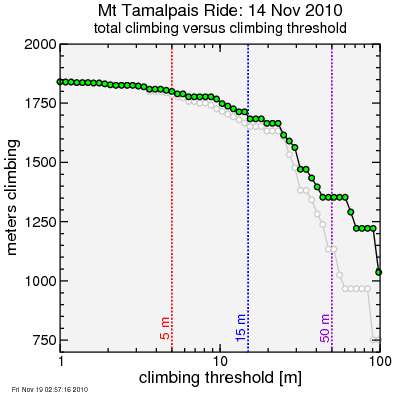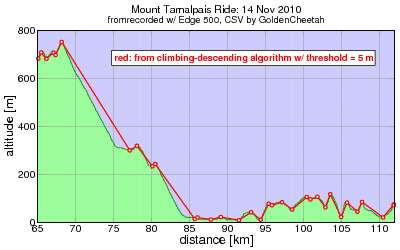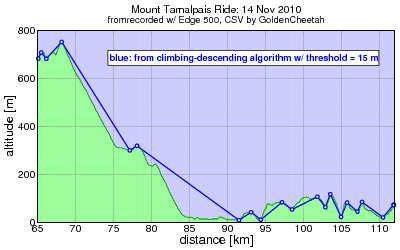testing the corrected total climbing algorithm
Okay, so déja-vu time. Once again I exercise my total climbing algorithm, except this time doing it right.
Here's the ride from last Sunday again, where I plot total climbing versus the climbing threshold. I've "greyed out" the result from the flawed version of the flawed algorithm. The difference is most evident for the larger values of the climbing threshold, where there's more pruning to be done. As long as pruning was on isolated segments, the old algorithm did okay. It's when multiple sequential climbs and descents were clipped that things went sour.

Now I look once again at the data from my ride. I plot here only the data from after I first crossed the west peak of Mt Tam. Here's the result using a 5 meter threshold, compared to the full measured profile:

Next, the 15 meter threshold. This did okay last time, and with the improved clipping, it does even better. 15 meters is close to the 50 foot threshold I believe was used with the old Avocet 50. However, it does merge the two climbs approaching the west peak, and when riding, those really do feel like two climbs separated by a descent, so I'd prefer they not be merged. Points to 5 meters. However, unlike the last time, the 15 meter algorithm is doing much better on the climbs in Sausalito and San Francisco.

So finally the 50 meter threshold. This one is clearly merging quite a lot. It has made substantial progress with the corrected algorithm, but still simply fails to give adequate recognition to the repeated onslaught of small steep hills San Francisco likes to dish out if you're not careful in route selection (and I have a habit "neglecting" to avoid the steep stuff).

Obviously this time I checked all of these using the reverse direction as well. Descending in the reverse direction should equal climbing in the forward. And indeed while the two directions don't necessarily result in the identical selection of points, they do always result in the same total climbing. In some cases there are multiple points at the same altitude and the direction may affect which how the ties are broken.
So there it is. I wish I hadn't made that mistake earlier, but I'm prone to mistakes. Sigh.
Here's the ride from last Sunday again, where I plot total climbing versus the climbing threshold. I've "greyed out" the result from the flawed version of the flawed algorithm. The difference is most evident for the larger values of the climbing threshold, where there's more pruning to be done. As long as pruning was on isolated segments, the old algorithm did okay. It's when multiple sequential climbs and descents were clipped that things went sour.

Now I look once again at the data from my ride. I plot here only the data from after I first crossed the west peak of Mt Tam. Here's the result using a 5 meter threshold, compared to the full measured profile:

Next, the 15 meter threshold. This did okay last time, and with the improved clipping, it does even better. 15 meters is close to the 50 foot threshold I believe was used with the old Avocet 50. However, it does merge the two climbs approaching the west peak, and when riding, those really do feel like two climbs separated by a descent, so I'd prefer they not be merged. Points to 5 meters. However, unlike the last time, the 15 meter algorithm is doing much better on the climbs in Sausalito and San Francisco.

So finally the 50 meter threshold. This one is clearly merging quite a lot. It has made substantial progress with the corrected algorithm, but still simply fails to give adequate recognition to the repeated onslaught of small steep hills San Francisco likes to dish out if you're not careful in route selection (and I have a habit "neglecting" to avoid the steep stuff).

Obviously this time I checked all of these using the reverse direction as well. Descending in the reverse direction should equal climbing in the forward. And indeed while the two directions don't necessarily result in the identical selection of points, they do always result in the same total climbing. In some cases there are multiple points at the same altitude and the direction may affect which how the ties are broken.
So there it is. I wish I hadn't made that mistake earlier, but I'm prone to mistakes. Sigh.

Comments